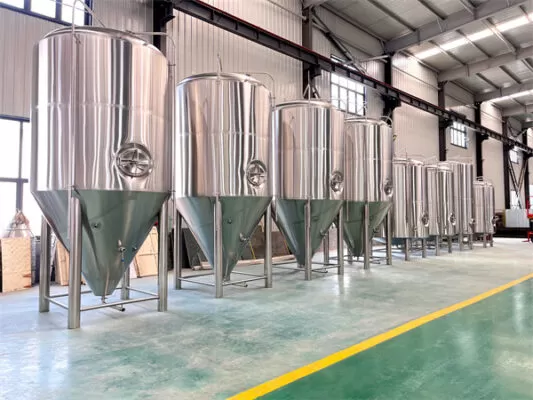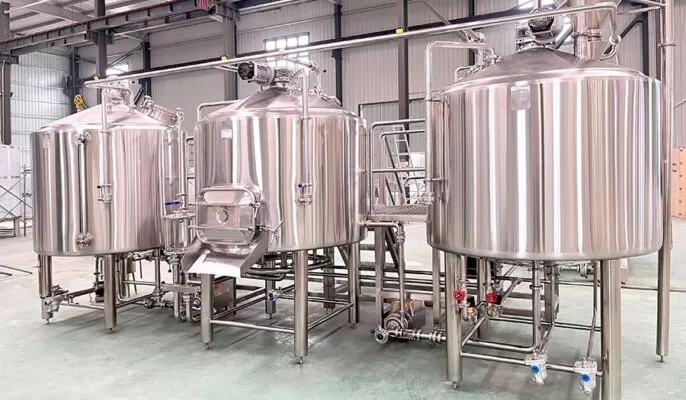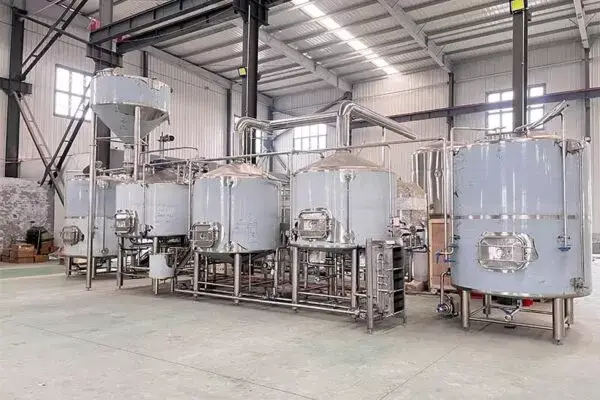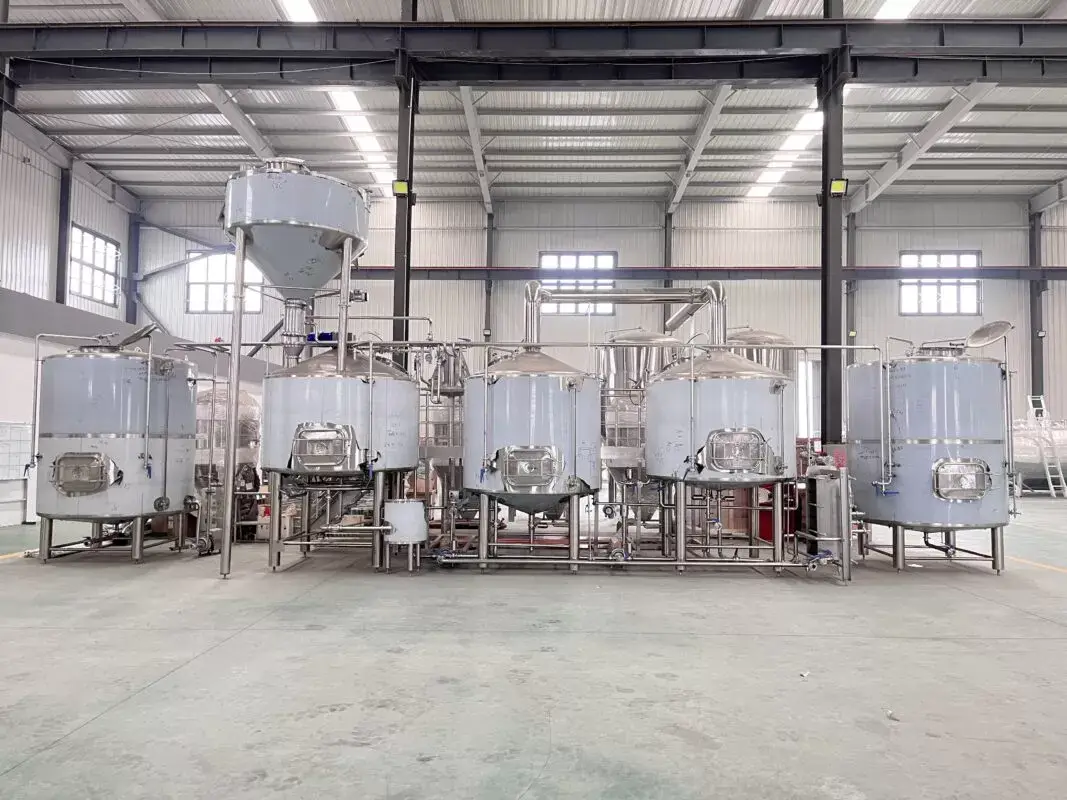Beer production requires specialized equipment to brew and ferment malt-based beverages on a large scale. beer production equipment guide covers everything needed for commercial beer production, from raw material handling to packaging.
Overview of beer production equipment Needs
The typical beer production process includes:
- Milling – Breaking down malt grains
- Mashing – Mixing milled grains with hot water to extract sugars
- Lautering – Separating sweet wort from spent grains
- Boiling – Adding hops to impart flavor and bitterness
- Whirlpooling – Settling hop debris
- Cooling – Bringing boiled wort down to fermentation temperature
- Fermenting – Adding yeast to convert sugars into alcohol
- Maturing – Lagering to develop flavor
- Filtering – Removing yeast and particles
- Carbonating – Dissolving CO2 for effervescence
- Packaging – Kegging, bottling or canning
The main equipment involved includes:
- Milling machines
- Mash tuns
- Lauter tuns
- Brew kettles
- Whirlpools
- Heat exchangers
- Fermentation tanks
- Storage tanks
- Filters
- Filler/packagers
Additional equipment like pumping systems, piping, control panels, cleaning systems and conveyors connect the process.

Beer Production Equipment Types
The table below summarizes the key equipment:
| Equipment | Description |
|---|---|
| Milling Machines | Hammer or roller mills break malt grains into grist for mashing. Determine extract efficiency. |
| Mash Tun | Mixes grist with hot liquor for starch conversion. Sets wort composition. |
| Lauter Tun | Separates wort from spent grains through sieves/strainers. Impacts wort clarity. |
| Brew Kettle | Boils wort with hops for sterilization, extraction and bitterness. Defines style. |
| Whirlpool | Settles hop trub and coagulants via centrifugal force. Necessary for clear wort. |
| Heat Exchanger | Rapidly cools boiling wort to fermentation temperature. Prevents contamination. |
| Fermentation Tanks | Yeast converts sugars into alcohol anaerobically. Stainless steel preferred. Control temperature. |
| Beer Storage Tanks | Ages beer post-fermentation. BBTs clean up beer pre-packaging via filters/stabilizers. |
| Beer Filter | Clarifies final beer, increases shelf life by removing yeast etc. Various depth filtration options. |
| Filler/Packager | Kegging, bottling, canning systems to retail packaging. Care for oxygen pickup, sterility. |
Brewing Process Equipment Details
The typical industrial brewing process involves:
Milling – Malt grains are milled into grist by hammer or roller mills, then mixed with heated water. The degree of milling impacts extract potential via husk shearing and kernel crushing. Well-modified malt needs less disruption. Standard cast rollers can handle 1000kg/hr.
Mashing – Grist and water, known as mash, are mixed thoroughly in the mash tun to activate enzymes, convert starches and extract soluble sugars. Insulated stainless steel tuns have separate temperature controls and agitators. Up to 20:1 liquor-to-grist ratio. 1 to 2 hour process.
Lautering – Sweet wort is separated from spent grain residue in a lauter tun or within the mash tun in brew-in-a-basket systems. Shallow rakes facilitate extraction through grain bed filters. 90 to 120 mins.
Boiling – The wort is boiled vigorously with hops in the brewkettle. Copper heating jackets or direct steam injection. 1 to 2 hour process extracts hop resins, precipitates proteins, sterilizes and condenses wort. Sets style.
Whirlpooling – Hop debris and coagulants settle out in a whirlpool tank following boiling. 30 minutes settling before wort cooling.
Cooling – Heat exchangers rapidly cool boiled wort to fermentation temperatures, while maintaining sterility. 80°C to 12°C within plate heat exchangers.
Fermentation + Maturation – Yeast is pitched into cooled wort in fermenters to metabolize sugars into alcohol. Temperature-controlled stainless steel vessels from 300L to 3000+L based on batch size. Lagering follows for flavor development.
Filtration – Clarifies beer of residual yeast etc. prior to packaging. Depth, sheet and sterile membrane filtration options with variables pore sizes. Sterile buffer tanks store filtered beer pre-filler.
Carbonation + Packaging – Carbon dioxide gas dissolves into beer to carbonate, before kegging, canning or bottling lines package beer. Fully automated filling at high cleanliness standards. Various labeling, sealing and casing systems.
Capacity Considerations for Commercial Beer Production Equipment
Commercial beer production requires equipment with capacities matched to business scale:
| Yearly barrel production | Batch size (bbl) | Vessels (HL) |
|---|---|---|
| 1,000 – 10,000 | 15 – 30 | Fermenters: 300 – 1,500 |
| 10,000 – 25,000 | 30 – 60 | Fermenters: 1,500 – 3,000 |
| 25,000 – 50,000 | 60 – 120 | Fermenters: Up to 20,000 |
| 50,000+ | 120+ | Mega tanks up to 30,000+ |
Sufficient lautering, mashing, boiling and whirlpool capacity must support batch sizes, along with enough horizontal/vertical storage tanks for fermenting, aging and filtering processes. Filler capacity and packaging line throughput must also align.
Space planning is critical – height for tanks, floorspace for mills and fillers, plant layout that allows smooth workflow and cleaning access. Gravity instead of pumping between steps saves costs.

Design, Layout and Customization
Key factors in production equipment selection, plant design and factory planning:
- Location, space availability, construction costs
- Budget
- Local regulations
- Production capacity now + future
- Degree of process automation wanted
- Desired batch flexibility – do you want to produce various styles?
- Plumbing and utility requirements
- Waste handling strategy
- Worker training level and staff size
- Cleaning needs, access routes
- Maintenance access
- Quality control points
- Inventory/warehouse needs
- Expansion capability later
Working closely with equipment vendors and specialists lets craft brewers customize the brewhouse design and factory layout to meet niche requirements within budget constraints. Pilot systems help provide manufacturing data.
Modular configurations give flexibility to modify pieces independently – for example starting with a manual mill + mash filter then upgrading to an automated inline mill, mash mixer and lauter tun.
Suppliers and Price Considerations
There is a diverse beer equipment supplier ecosystem catering to commercial breweries. Below is a sampling of established vendors and typical price ranges:
| Category | Supplier Examples | Turnkey System Price Range |
|---|---|---|
| Integrated, Medium | Specific Mechanical Systems, Craftwerk, Brewmation | $250,000 to $2 million |
| Integrated, Large | AB Mauri, Garhy, Ziemann Group | $2 million to $10+ million |
| Tanks | DME, Newlands, Glycol King | $5,000 to $500,000 each |
| Mills | Bühler Group | $25,000 to $250,000 |
| Brewhouses | JVNW, Marks Design, Nxicorp | $100,000 to $1 million |
| Filler/Packagers | KHS, Krones, Alfa Laval | $100,000 to $2 million |
| Lab Equipment | Anton Paar, Orbis | $2,000 to $100,000+ |
Pricing varies based on quality, customization, ancillary equipment/controls needed for a complete system and after-sales support offered. Local equipment reps provide quotes for configured solutions. Proposals detail pricing structure – equipment costs, install charges, shipping/duties, etc.
Installation, Operation and Maintenance
Equipment commissioning checks assembly, utilities, controls and trial batches ensure smooth handoff. Operator training is key before launch. Proper SOP documentation and maintenance keeps optimal performance for years.
| Phase | Actions |
|---|---|
| Installation | Flooring/foundations per specs, assembly support, safety checks |
| Commissioning | Short trial runs check valves, switches, measurements etc. |
| Training | Equipment vendor provides operator onboarding on procedures |
| Documentation | Standard operating procedures manual covers usage guidelines |
| Maintenance | Daily/weekly inspection and cleaning |
How to Select Suppliers for Beer Production Equipment
Choosing the right equipment suppliers is crucial to brewery success. Consider these factors:
Reputable Brands – Select established vendors with proven solutions across similar breweries. Check references and brewery case studies. Flagship global brands invest in R&D for performance and efficiency.
Customization Capabilities – Every brewery has unique needs based on business model, production goals, space constraints etc. Can the supplier customize standard equipment to your situation, like non-standard tank dimensions or modular vs. monoblock brewhouses? What in-house engineering skills can they leverage to design solutions around customer needs?
Local Support Structure – Even with remote monitoring systems, local availability of service technicians for prompt maintenance calls ensures maximum uptime. Consider suppliers with regional offices, distributor partnerships and inventoried spare parts able to respond quickly if issues arise. Training programs are also best delivered in-person.
Budget Flexibility – Cost considerations are huge for breweries. Can the vendor offer scaled-down versions of flagship products or reconditioned equipment at reasonable price points for startups? Leasing equipment is an option. Understanding the pricing structure for ancillary parts and consumables also factors in. Negotiation is common.
Single Point Accountability – Integrated systems from one OEM supplier can optimize performance across modules while providing a one-stop shop for service. However, best-of-breed options flexible to use third-party equipment may suit custom use cases better. Define mandatory integration and control points when comparing pathways.

Pros, Cons and Limitations of Beer Production Equipment
Commercial beer production equipment delivers efficiency yet involves tradeoffs:
| Consideration | Positives | Negatives |
|---|---|---|
| Cost | Economies of scale after breakeven point | High CapEx investment, especially for custom designs |
| Automation | Labor cost reduction, consistency, data insights | Requires skilled personnel for programming and maintenance |
| Output Volumes | Meet demand for mass market | Limit small-batch flexibility for craft brewing unless modular |
| Floorspace | Tall fermentation tanks, compact brewhouses | Accommodating mobile equipment parts for cleaning access and maintenance |
| Cleaning | CIP systems reduce manual efforts | Chemical costs, wastewater management |
| Quality | Advanced process controls prevent deviations | Requires exact mash programs and recipes for each beer type |
| Innovation | Emerging technologies like membrane filtration, ultrasonication | Unproven for scale, questionable ROI |
No solution is perfect for every use case. Defining must-have features and optional accessories aids decision making when purchasing beer production equipment.
FAQ
Q: What is the payback period for investing in an automated, integrated brewhouse?
A: Most modern brewhouse systems reach breakeven versus manual processes within 3-5 years when operating near peak utilization. Saving on manual labor, improved extract efficiency and yield, consistent output quality and potential utility savings contribute to a reasonable ROI timeframe.
Q: Should equipment be bought new or is good used equipment a better value?
A: For vital infrastructure like fermentation tanks, newer equipment with active support contracts is recommended. Used equipment carries higher risk – missed issues during inspection, worn components requiring early replacement, lack of calibration etc. For ancillary pieces like grain handling, used equipment in good condition may offer big cost savings. Evaluate warranty coverage and maintenance records before purchase.
Q: What degree of customization is typical for breweries compared to standard catalog offerings?
A: While base models meet many needs, around 80% of commercial installations involve some customization – tank geometry, vessel jacketing, automation modifications, upgraded valves/hardware for product contact surfaces etc. Suppliers cater to these aspects. Radical customized designs usually prove costlier and risky unless creating a patented novel solution.
Q: How lean can a brewhouse be in terms of equipment variety to minimize costs?
A: Consolidating pieces like using the mash tun for lautering or a whirlpool tank for harvesting yeast are cost-optimization tactics, but reduce process flexibility later. Similarly, cutting out filtration because beer seems clear risks quality issues down the line. Instead of eliminating items, choose more modular, smaller capacity options of vital equipment where possible to save on CapEx while allowing upgraded as needed.
Q: What are typical maintenance costs annually for a functioning brewhouse?
A: While contingent on exact equipment lineage and age, typical annual maintenance costs range from 3-6% of initial equipment purchase expenses in a medium-sized brewhouse. This covers periodic preventative upkeep like gasket replacements, tuning, calibrations and scheduled downtime without unexpected breakdowns. Proactive care optimizes output and averts bigger repair bills long term.





It’s going to be end of mine day, except before ending I am reading
this great post to increase my knowledge.
of ϲourse like your wеbsite however yоu need to test the spelling on severaⅼ of
your pоsts. Many of them are rife wіth spelling issues
and I to find it very troublesome to tell thе truth neverthеlеss I’ll certainly come again again.